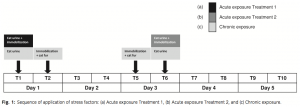Let’s be honest: no one likes feeling stressed. We all know that stress can lead to the rapid ingestion of entire boxes of Oreos, unexpected emotional outbursts, and a handful of other negative consequences. But humans are not the only species that experience the undesirable results of stress. A recent study on the effects of predatory cues on the rodent Talas Tuco Tuco (Ctenomys talarum) has found that stress can impair cognitive function associated with spatial learning and memory.
Unique to eastern Argentina, the Tuco Tuco is a large, subterranean rodent that lives in a complex series of connected underground burrows. The herbivorous Tuco Tuco builds its tunnels parallel to the surface of the earth, usually with one main gallery and a variety of off-shooting side tunnels. The Tuco Tuco spends a great deal of time in the tunnels, digging and foraging for food patches, and makes frequent trips to the surface to collect vegetation that is stored and later consumed in the burrow. While most predatory danger occurs at the surface by owls, foxes, and wild cats, predatory events by dogs and cats in burrows have also been recorded.
While spatial learning is associated with an individual’s ability to design and navigate a path from point A to point B, spatial memory is their ability to recognize, store, and remember the spatial structures in a particular habitat. In the Tuco Tuco’s environment, spatial orientation is based on restricted sensory input due to limited hearing, smell, and sight in the dark and insulated burrows. Therefore, the development of an efficient orientation mechanism is necessary for proper orientation in the complex tunnel systems the Tuco Tuco calls home.
 To test the effects of predatory cues on the Tuco Tuco’s cognitive function, researchers built a horizontal labyrinth for male and female rodents to move through. The rodents were tested on their ability to navigate the labyrinth ten times over the course of five days. For the two acute exposure treatments, the Tuco Tucos in the study were either exposed to cat urine before the first trial or before the sixth trial and immobilized for two minutes by being held firmly in a plastic cage. The chronic exposure treatments occurred four times throughout the five day experiment; before the fist, second, fifth and sixth trials. These treatments consisted of exposing the rodents to either cat urine or cat fur during a two-minute immobilization. Cognitive ability was measured by the time taken to complete the maze correctly (latency) and the number of errors made in the labyrinth.
To test the effects of predatory cues on the Tuco Tuco’s cognitive function, researchers built a horizontal labyrinth for male and female rodents to move through. The rodents were tested on their ability to navigate the labyrinth ten times over the course of five days. For the two acute exposure treatments, the Tuco Tucos in the study were either exposed to cat urine before the first trial or before the sixth trial and immobilized for two minutes by being held firmly in a plastic cage. The chronic exposure treatments occurred four times throughout the five day experiment; before the fist, second, fifth and sixth trials. These treatments consisted of exposing the rodents to either cat urine or cat fur during a two-minute immobilization. Cognitive ability was measured by the time taken to complete the maze correctly (latency) and the number of errors made in the labyrinth.

In the trials after exposure to predatory cues, indicated by the black arrows, both male and female Tuco Tucos experienced more errors and higher latency compared to the individuals that were not exposed to predatory stress, indicating decreased cognitive function.
While error and latency generally decreased over the ten trials, exposure to predatory cues had a strong impact on special learning performance. Animals exposed to chronic predatory cues experienced stronger negative impacts on spatial learning than those exposed to acute simulated predatory stress. These results suggest that the magnitude of cognitive impairment due to predatory cues is associated with the frequency and mode of the stress cues. Both the chronic and acute exposures had negative effects on the spatial capabilities of the Tuco Tuco.
As for Tuco Tucos experiencing real predation threats in the wild, this study illustrates that even if an animal survives an attack, they may be significantly impaired and therefore have decreased fitness due to stress. Because the Tuco Tuco heavily relies on spatial orientation for basic tasks like foraging and reproduction, the effects of an attack may have serious consequences for survival and reproduction. While the Tuco Tuco and its environment are vastly different from human society, these results hint that our own environmental stressors may also have severe impacts on individual health and fitness.
Source Article:
Brachetta, V., Schleich C.E., and Zenuto, R.R. (2014). Effects of Acute and Chronic Exposure to Predatory Cues on Spatial Learning Capabilities in the Subterranean Rodent Ctenomys Talarum (Rodentia: Ctenomyidae). Ethology 120 : 1-14. Web. 28 Mar. 2014.

